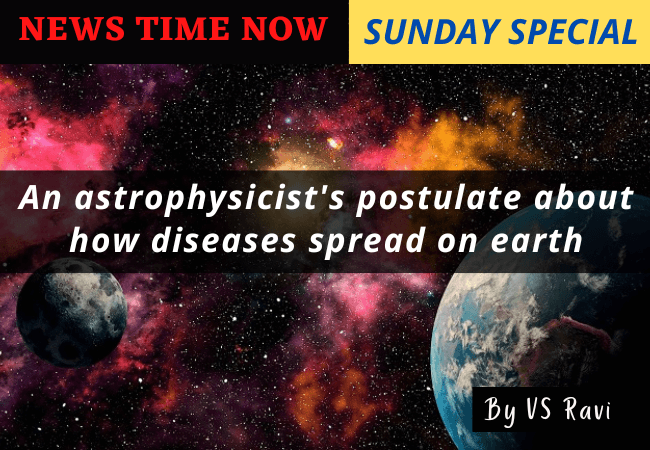Fade far away dissolve and quite forget
What thou amongst the leaves has never known
The weariness the fever and the fret
Here where men sit and hear each other groan
Where palsy shakes a few sad last grey hairs
Where youth grows pale and spectre thin and dies.
Wrote Keats in what is perhaps regarded as his greatest poem ‘Ode to a Nightingale’ referring to the disease that was ravaging his lungs, but which in his view that immortal bird would never have to fear. One wonders what he would have had to say to a man like Hoyle, England’s great astrophysicist who has come out with a new theory about diseases.
The Big Bang theory, which is now accepted by the entire scientific community states that the Universe originated from an incredibly hot and dense state 13.7 billion years ago and has been expanding and cooling ever since. It is now generally accepted by most cosmologists. However, this hasn’t always been the case and for a while the Steady State theory had been very popular. This theory was developed in 1948 by Fred Hoyle, Herman Bondi and Thomas Gold as an alternative to the Big Bang to explain the origin and expansion of the Universe. At the heart of the Steady State theory is the Perfect Cosmological Principle. This states that the Universe is infinite in extent, infinitely old and, taken as a whole, it is the same in all directions and at all times in the past and at all times in the future. In other words, the Universe doesn’t evolve or change over time.
The theory does acknowledge that change takes place on a smaller scale. If we take a small region of the Universe, such as the neighbourhood of the Sun, it does change over time as individual stars burn up their fuel and die, eventually becoming objects such as black dwarfs, neutrons stars and black holes. The Steady State theory proposes that new stars are continually created all the time at the rate needed to replace the stars which have used up their fuel and have stopped shining. So, if we take a large enough region of space, and by large we mean tens of millions of light years (a light year is the distance travelled by light at the speed of 186000 miles per second for a whole year) across, the average amount of light emitted doesn’t change over time.
Sir Fred Hoyle has always been a controversial and colourful figure. His turbulent, far-fetched and what may appear as rather strange ideas have always generated intense speculation among intellectual circles. Some of his theories have sometimes startled the scientific establishment. While scientists, on the one hand, find it difficult to accept his revolutionary views, on the other hand, they are reluctant to brush them aside as mere fantasy having regard to his experience, fame and stature. For example according to Hoyle the so-called expansion of the universe does not actually take place but is only an illusion caused by the measuring instruments which were shrinking in size. The effect according to Hoyle was also due to some other physical quantities.
Hoyle once again took the scientific community by storm when he put forth his idea that life did not originate on Earth but that our planet was originally seeded with living organisms from outer space. Hoyle’s theory, in this sense, seems to be similar to the idea recently put forth by the Nobel Prize-winning biologist Francis Crick. According to Crick, an advanced civilisation that had developed billions of years ago had sent an unmanned space rocket carrying primitive spores to the Earth and that this was the first state in the origin and evolution of life, on our planet.
A few years ago, Hoyle once again stirred up a hornet’s nest by revising his theory regarding the origin of life in his attempt to explain why unwelcome viruses continue to arrive on our Earth to trouble mankind even today. Hoyle’s theories generated a controversy because of increased concern over the origin of novel strains of influenza. The question is whether Hoyle’s ideas can convincingly explain the phenomena observed.
In his earlier theory, Hoyle had postulated that some four billion years ago, comets brought prebiotic substances to our Earth. Then, according to him, micro-meteors ferried life itself, but then the question arises as to why clouds of viruses are continuing to rain down upon us, accounting for intermittent ravages of such infections as influenza, cholera or even the common cold.
The main idea that Hoyle seems to be conveying is that there is a definite pattern which he is able to discern in the outbreak of such diseases. According to his hypothesis, they seem to occur just as if the microbes responsible have been arriving sporadically and ‘vertically’ instead of being transmitted ‘horizontally’ across the planet from person to person. Observations made in some schools and colleges in Cardiff, Wales (UK) seemed to support Hoyle’s new theory. Some students’ living quarters had been heavily affected by influenza while others had been left untouched. The infection had not been randomly distributed as one would have expected if the people were passing the virus to each other.
Those who oppose Hoyle’s theories cite three points in support of their arguments. First, microbes cannot tolerate the radiation in outer space. Secondly, in their view we now understand perfectly well how new influenza viruses arise by genetic recombination among old ones. Thirdly, it is inconceivable that micro-organisms generated in space should be so exquisitely and perfectly engineered as to invade the human respiratory tract in an efficient manner. Supporters of Hoyle’s theories seem to think that they are able to answer the first objection in a most convincing manner. Bacteria and viruses have highly efficient mechanisms to repair damage caused by ultraviolet light at wavelengths they do not experience on Earth. But to argue as the sceptics do that these evolved to sustain micro- organisms before this planet acquired an atmosphere evades an important point. Why should such a machinery continue to exist billions of years after it was no longer required? Hoyle’ s answer is that the machinery exists so that the microbes can journey from fantastic distances deep in space to the Earth.
The alarming feature of the second sceptical argument is that although conservatives try to give what they think is a satisfying account of how flu viruses originate and develop, the past decade has witnessed a renewed controversy over the whole subject. According to an article which had appeared some years ago in a prestigious British medical journal, we still need proper evidence to show how flu viruses survive very efficiently. The article mentions work done by one scientist whose findings show that the flu virus does not persist in the community by being transmitted from one individual to another.
Some scientists in one school of medicine in New York City are still puzzled over why one particular kind of virus re-emerged in 1977 after having disappeared in the late 1950s. Amid such uncertainty, is it correct on anyone’s part to dismiss Hoyle’s theories as scientific fiction?
The third criticism, however, must be taken more seriously Why is the influenza virus so beautifully designed to invade the respiratory tract of Homo sapiens if it is a product of interstellar space? The staggering complexity of flu virus—with components perfectly adapted to penetrate particular tissues and then mobilise the cell’s machinery to fabricate new particles—surely supports the idea that it originated on the Earth, not in space far from the dictates of organic evolution as biologists understand the process.
None the less, the practical implications of the last possibility are disturbing. If influenza and other plagues do emerge in outer space, our skill in dealing with them is undoubtedly built on a shakier foundation than we had supposed. Is it possible that reluctance on the part of some people to accept such a possibility is behind their eagerness to reject Hoyle’s theories? Before another revolution takes place in biology, it would be too premature to dismiss the theories of scientists like Hoyle however far-fetched they may seem at present—given Hoyle’s stature and reputation in modern cosmology.


















































